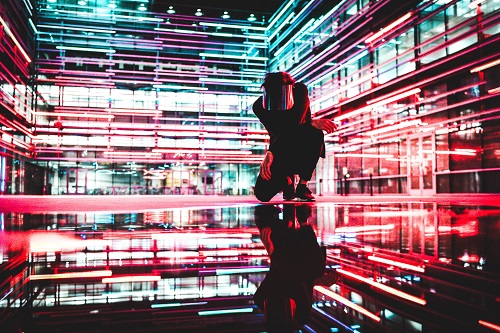Virtual reality… To some, it’s an over-hyped craze that might one day produce some cool video games.
To others, it’s a phenomenon that will one day alter our everyday lives.
As far as its societal impact… will virtual reality be the next World Wide Web? The next mobile phone? Or some other technological advancement that revolutionizes our society?
Sure, it’s hard to believe. But as the technology continues to improve, and as new applications are discovered, there is an argument to be made that virtual reality will change many facets of our lives.
In this article, we’ll create some interesting scenarios that might change the way you feel about virtual reality. Some might seem far-fetched. Others might dip into the realm of possibility.
Either way, there are both positive and negative sides of virtual reality that could change the way we experience the world – both in physical reality and virtual reality.
The Future of Virtual Reality
The reality is, virtual reality is a concept that has been around for several decades. The 90s brought some practical uses of VR in the form of video games. But due to the prematurity of the technology, it never really took off – with exception to games you might find at an arcade.
If you are an avid advocate of virtual reality, there’s a good chance you’ve already read Ernest Cline’s book, “Ready Player One” (if not, it is a must).
If you haven’t already read it, here’s a backdrop of the novel’s setting:
It’s the year 2045 and society has broken down due to overpopulation, energy scarcity, and extreme unemployment. To escape their miserable lives, people have turned to the OASIS, an incredibly realistic virtual reality environment. The OASIS is more than just a video game. People have jobs in this virtual world, students attend school in virtual classrooms, and on and on.
While there’s a lot more to the story, the underlying theme is compelling. And it begs a profound question:
Why spend time in the real world when you can enter a virtual world where you can be anyone and go anywhere?
How far virtual reality will go depends largely on how well it fulfills the five senses. Here’s where VR currently stands in this area:
- Sight: Obviously this one is covered. Sight is the pillar of VR.
- Hearing: Also covered. Put on a high quality pair of headphones and you’ll be sucked into the experience.
- Touch: It’s getting there with accessories that have impressive haptic feedback capabilities.
- Smell: Not quite there, but it’ll be coming. A company called VAQSO is developing a VR add-on device that syncs to scenes or action (i.e. smelling simulated gunsmoke after firing a virtual gun).
- Taste: The verdict is still out, but there are ideas in the works.

So VR’s far-reaching potential depends on a few things. Most important is the technology itself. If VR can master the five senses, it’s hard to imagine a world without it.
Consumer adoption is another crucial factor. Companies like Samsung have helped immensely by shipping out hundreds of thousands of headsets as promotional items. You’ll also find reasonably priced headsets on end-caps at major retailers.
Adoption goes hand-in-hand with application development. As more people start using VR there will be greater incentives for companies to design applications. Just think about smartphone apps. As the mobile phone market has grown exponentially, so have the Android and Apple app stores.
Note: Are you a tech buff? Looking for ways to improve your home? Click here for the latest and greatest tech gadgets – along with apparel and other hip new products.
The Positives
First, the positive impact virtual reality could have on society…
The social aspect is the most glaring factor.
Now, saying virtual reality will help us become more “social” might seem counter-intuitive. Considering that sitting on your couch with a headset covering your face, in fact, might seem anti-social (certain aspects of this certainly would fall under the “negative societal impact” category).
However, think about your friends and family members who live on the other side of the country. If you live in California, you’d probably be lucky to see your relatives in New York more than once or twice per year.
With a realistic VR experience, you can spend time with distant loved ones at the touch of a button. Think about the first time you used FaceTime or some other video conferencing software. It’s a lot different than just making a phone call. VR multiplies this more linear communication medium hundreds-fold.
You could have a weekly poker night with some friends from college (who live in 5 different states). You could “sit down” with your parents – who live 400 miles away – and reminisce about your childhood. Etc.
Then there are plenty of practical, non-recreational benefits:
- Conduct virtual business meetings with teams across the world.
- Get a better view of e-commerce products before making purchases.
- Get a virtual tour of London before booking a plane ticket (of course, if VR is so realistic, why book the ticket at all?).
The more accurate that “avatars” become, the more realistic the experience will feel. In fact, you would think we’d move way beyond avatars, where digital photography can portray a near-100 percent likeliness to our actual appearance.
 The Negatives
The Negatives
Now, onto the potential negative societal impact of a VR-driven future.
The most egregious con of virtual reality would be the propensity for escapism. Meaning, if someone is depressed and unhappy with your life, they might use VR as an escape by entering a different world where they don’t have to be themselves.
Social media has given us a small dose of this. People hide behind their computers and treat people in ways that they wouldn’t treat them if they were right in front of them.
Health is another concern. And not just the more obvious health concerns (vision degradation, seizures, etc.), but health problems that could develop over extended use.
If we become so obsessed with our fantasy worlds, where we are working, socializing, and rec-reating in virtual reality, what will happen to our bodies? Fourteen hours a day in a state of physical idleness can’t be healthy.
Note: To be fair, if VR were to reach these heights, there would be remedies. In fact, there are already contraptions (similar to treadmills and other exercise equipment) that allow you to physically move in the VR world. But still, when would we get sunlight and fresh air?
So Many Questions…
You can see there are a number of potential positives and negatives to virtual reality.
And as noted, whether these pros and cons will ever fully be realized depends on technology, adoption, and development.
So with that we’ll leave you with a few more questions to whet your appetite:
- Why go to the mall to enhance your wardrobe when you can buy a nice pair of digital jeans or perfectly tailored dress or suit?
- Why commute to a stadium to watch your professional sports team play when you could sit on your couch with a 360-degree virtual seat inside the stadium?
- Why host a party in a cramped 600 square foot apartment when you could host a luxurious party in a 7,000 square foot virtual mansion?
- Why save up for an exorbitantly-priced trip to Hawaii when you could take monthly virtual vacations all around the world – for free or for a nominal price?
Do you love all things tech? Check out the latest gadgets from Touch of Modern.
